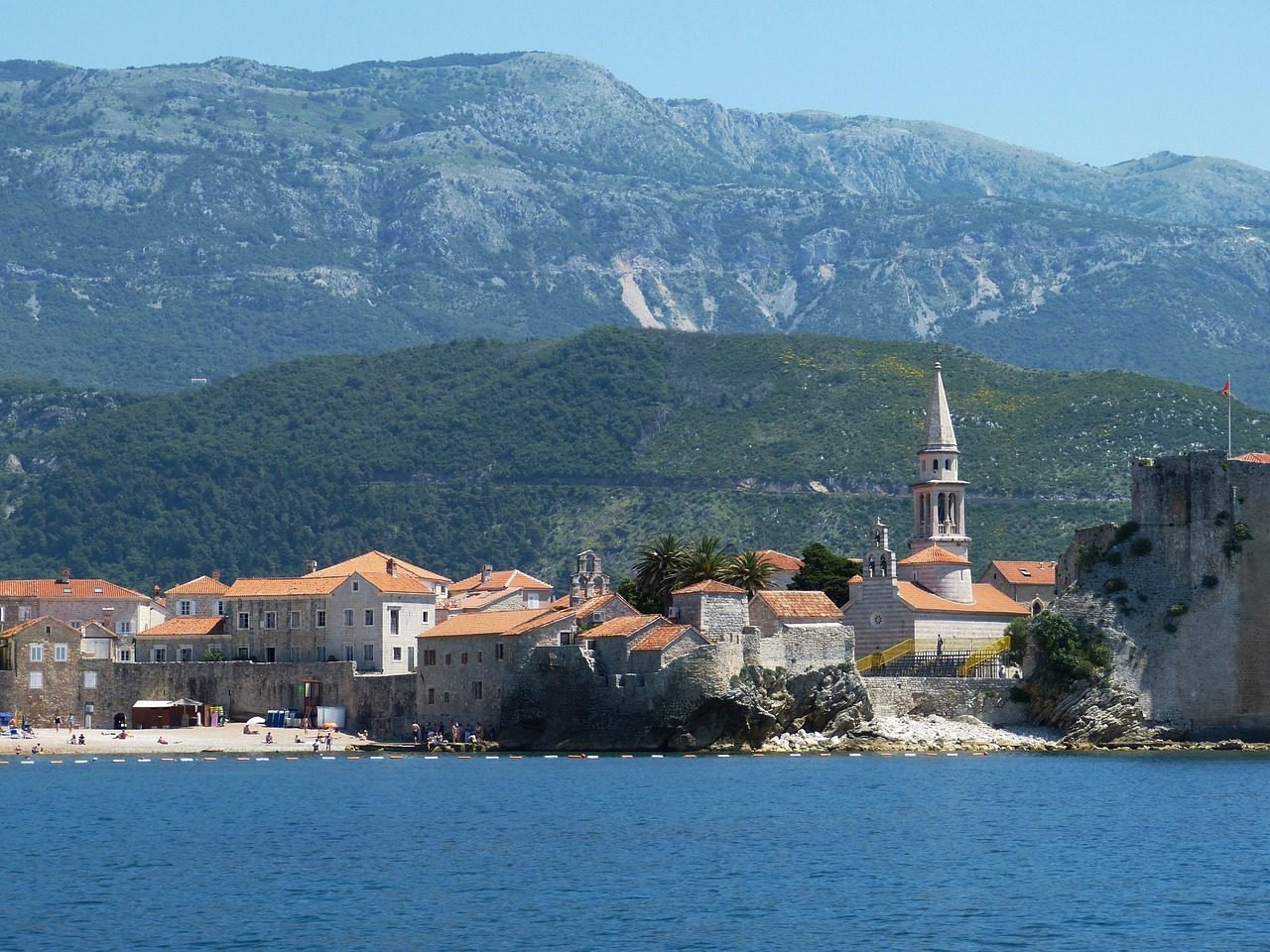Best Places to Visit in Croatia: Top Attractions
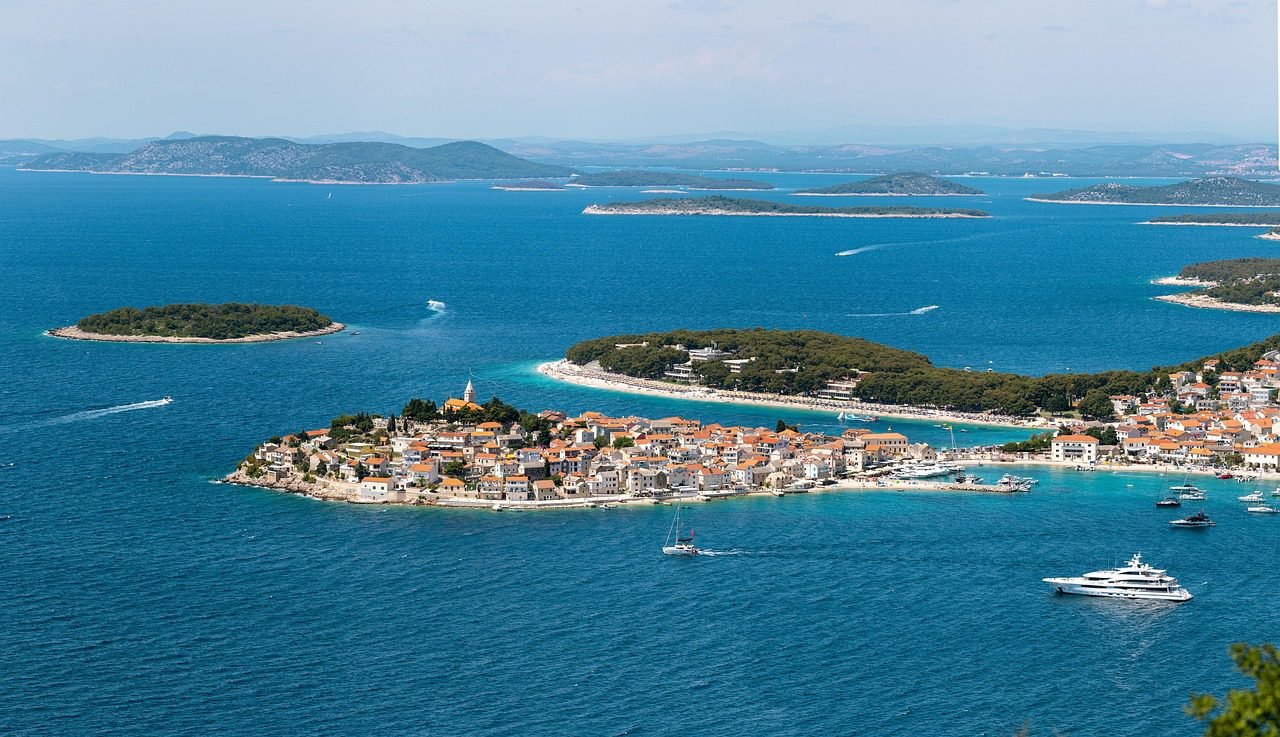
Croatia, a jewel of the Adriatic and the Balkans, offers a captivating blend of ancient history, stunning natural beauty, and vibrant culture, making it an ideal destination for every traveler. From its pristine national parks to its historic coastal cities and charming islands, this guide will help you navigate the best places to visit in Croatia, ensuring a memorable journey through this diverse and enchanting country.
Key Takeaways
- Plitvice Lakes National Park: A UNESCO World Heritage site renowned for its cascading lakes and waterfalls.
- Dubrovnik: The fortified “Pearl of the Adriatic” with rich history and stunning architecture.
- Split: Home to the ancient Diocletian’s Palace, a living historical monument.
- Hvar Island is a popular spot known for its vibrant nightlife and beautiful beaches.
- Korčula Town: Often called “mini-Dubrovnik,” with its charming old town and medieval walls.
- Istria: A region offering picturesque hilltop towns, vineyards, and a truffle-rich culinary scene.
- Zadar: Famous for its unique Sea Organ and Sun Salutation installations, offering spectacular sunsets.
What are the must-visit natural wonders in Croatia?
Croatia’s diverse landscape is a treasure trove of natural beauty, from cascading waterfalls to serene lakes and rugged coastlines.
But what truly sets these natural wonders apart, and how can you best experience their unique charm?
Exploring the Emerald Terraces of Plitvice Lakes National Park
Plitvice Lakes National Park is arguably Croatia’s most famous natural attraction, a UNESCO World Heritage site that captivates visitors with its 16 interconnected lakes, arranged in cascades and separated by natural travertine barriers.

The lakes’ colors shift from azure to green, grey, or blue, depending on the mineral content of the water and the angle of sunlight.
Wooden boardwalks and pathways wind around and across the lakes, offering intimate views of the waterfalls and the pristine environment.
This natural phenomenon is a testament to the power of water and time, creating a landscape that feels almost otherworldly.
Definition: Travertine is a form of limestone deposited by mineral springs, often found in areas with hot springs. In Plitvice, it forms natural dams that create the park’s iconic lake system.
Discovering the Aquatic Paradise of Krka National Park
Further south, Krka National Park offers another spectacular display of Croatia’s aquatic wonders.

While similar to Plitvice in its emphasis on waterfalls and lakes, Krka provides a different experience, with opportunities for swimming in designated areas near some of its magnificent falls, such as Skradinski Buk.
The park is also rich in historical and cultural monuments, including ancient watermills and monasteries.
The Krka River, the park’s namesake, carves its way through a dramatic canyon, creating a series of seven waterfalls that are a delight to explore.
Unveiling the Untamed Beauty of Mljet National Park
For those seeking a more tranquil natural escape, Mljet National Park on Mljet Island offers a serene retreat.
Covered in dense pine forests, the park encompasses two saltwater lakes, Veliko Jezero and Malo Jezero, which are connected to the sea. In the center of Veliko Jezero lies a small island, St. Mary, home to a 12th-century Benedictine monastery.
The park is ideal for cycling, kayaking, and hiking, allowing visitors to immerse themselves in its untouched natural beauty.
Which historical cities and cultural hubs should you explore in Croatia?
Croatia’s rich history is etched into its ancient cities, each telling a story of empires, trade, and cultural exchange. From Roman palaces to medieval walled towns, these urban centers offer a deep dive into the country’s past.
But how do you choose which historical gems to visit, and what unique experiences do they offer?
You may like our guide about the Ultimate Guide to Best Balkans Tours & Trips 202
Stepping Back in Time in Dubrovnik: The Pearl of the Adriatic
Dubrovnik, often hailed as the “Pearl of the Adriatic,” is a city that needs little introduction.
Its magnificent Old Town, encircled by massive medieval walls, is a UNESCO World Heritage site and a living museum.

Walking atop these walls offers breathtaking panoramic views of the terracotta rooftops, the shimmering Adriatic Sea, and the bustling streets below.
Inside the walls, you’ll discover a labyrinth of narrow alleys, charming squares, and impressive architectural marvels like the Rector’s Palace, Sponza Palace, and the Dubrovnik Cathedral.
The city’s resilience, having rebuilt itself after conflicts, adds another layer to its compelling narrative.
Unveiling Ancient Grandeur in Split: Diocletian’s Palace
Split, Croatia’s second-largest city, is unique in that its historical heart is a 4th-century Roman palace.

Diocletian’s Palace is not merely a ruin but a vibrant, living complex of streets, shops, cafes, and homes.
As you wander through its ancient Peristyle, explore the cellars, or climb the bell tower of the Cathedral of Saint Domnius, you’re walking through layers of history.
The palace’s integration into the modern city creates a fascinating juxtaposition of old and new, where ancient Roman architecture coexists seamlessly with contemporary life.
Discovering Roman Heritage in Pula and Zadar
While Dubrovnik and Split are often the main draws, cities like Pula and Zadar offer equally compelling historical narratives.
Pula, located on the Istrian peninsula, is home to one of the best-preserved Roman amphitheaters outside of Italy, the Pula Arena.
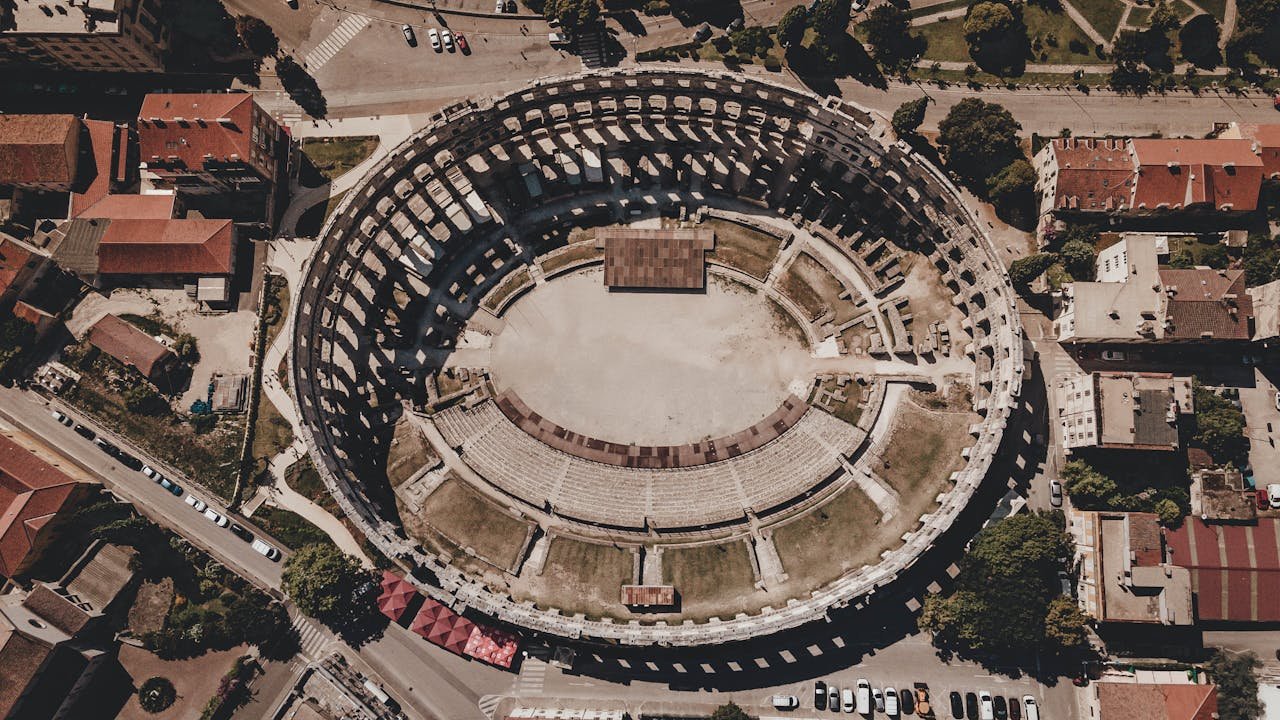
This impressive structure once hosted gladiatorial contests and now serves as a venue for concerts and festivals.
Zadar, on the other hand, boasts a compact Old Town filled with Roman ruins, medieval churches, and Venetian fortifications.
Beyond its historical sites, Zadar is famous for its modern art installations, the Sea Organ and the Sun Salutation, which transform the city’s waterfront into a sensory experience, especially at sunset.
What are the best Croatian islands and coastal towns for your vacation?
Croatia’s coastline is dotted with thousands of islands, each offering a unique charm, from bustling party hubs to tranquil retreats.
The coastal towns, with their picturesque harbors and ancient architecture, serve as perfect gateways to these island paradises.
But with so many options, how do you choose the perfect island escape or coastal base for your Croatian adventure?
The Glamour and Charm of Hvar Island
Hvar Island is one of Croatia’s most popular and glamorous destinations, known for its vibrant nightlife, beautiful beaches, and historic Hvar Town.
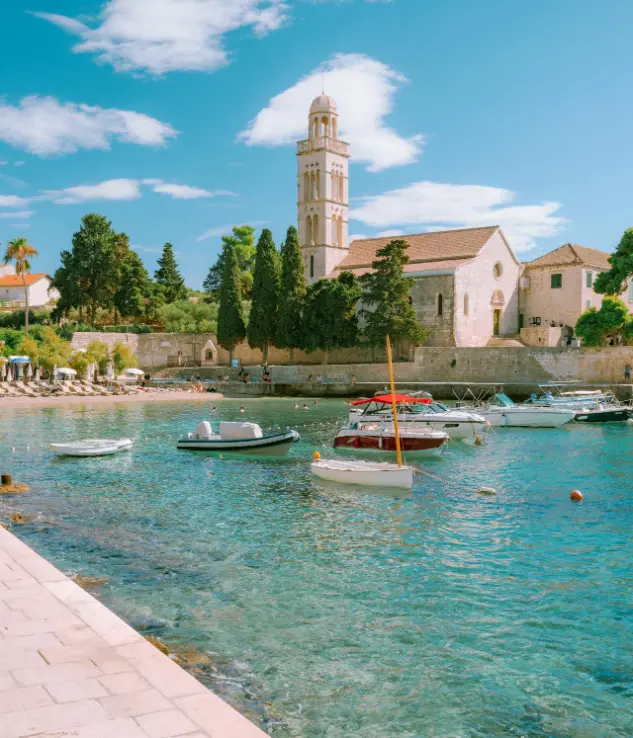
The town itself is dominated by the 16th-century Fortica fortress, offering panoramic views of the Pakleni Islands and the sparkling Adriatic.
Beyond the parties, Hvar offers lavender fields, ancient olive groves, and charming inland villages.
The Pakleni Islands, a short boat ride away, provide secluded coves and crystal-clear waters perfect for swimming and sunbathing.
Korčula: A Walled Town with a Rich Heritage
Often referred to as a “mini-Dubrovnik,” Korčula Town on Korčula Island is a beautifully preserved medieval walled town.
Its narrow, cobbled streets are laid out in a unique fishbone pattern, designed to protect against winds.
Legend has it that Marco Polo was born here, and you can even visit a museum dedicated to him.
The island itself is covered in dense forests, vineyards, and olive groves, offering a more relaxed pace than some of its busier neighbors. Korčula is also famous for its Moreska sword dance, a traditional performance with roots in the medieval period.
Vis Island: An Untouched Gem
For those seeking an authentic and less-touristy experience, Vis Island is an ideal choice. For decades, Vis was a Yugoslav military base, which kept it isolated from mass tourism.
This isolation has preserved its natural beauty and laid-back atmosphere. The island boasts stunning hidden bays, pristine beaches like Stiniva Bay (accessible by a steep path or boat), and charming towns like Vis and Komiža.
Vis is also renowned for its excellent local wines and fresh seafood, offering a true taste of traditional Croatian island life.
Brač Island and the Iconic Zlatni Rat Beach
Brač Island is the largest of the Central Dalmatian islands and is famous for its distinctive white stone, used in buildings worldwide, including the White House.
Its most iconic feature is Zlatni Rat beach (Golden Horn) near the town of Bol, a unique, ever-shifting pebble spit that extends into the Adriatic SeaZlatni Rat beach (Golden Horn) near the town of Bol, a unique, ever-shifting pebble spit that extends into the Adriatic Sea.
The beach’s shape changes with the currents and winds, making it a popular spot for windsurfing and kitesurfing, which is one reason to visit this beautiful country.
Beyond the beach, Brač offers charming villages, olive groves, and Vidova Gora, the highest peak in the Adriatic islands, providing breathtaking views.
When is the best time to visit Croatia?
Choosing the right time to visit Croatia can significantly impact your experience, as the country experiences distinct seasons, each with its advantages and disadvantages.
Are you dreaming of sun-drenched beaches and vibrant nightlife, or do you prefer cooler temperatures and fewer crowds for exploring historical sites?
Understanding the seasonal nuances will help you plan your perfect Croatian getaway, especially if you’re considering a week in Croatia.
Summer (June to August): Sun, Sea, and Crowds
Summer is undoubtedly the most popular time to visit Croatia, especially for those drawn to its stunning coastline and islands. The weather is consistently warm and sunny, with average temperatures ranging from 25°C to 30°C (77°F to 86°F).
This is the peak season for swimming, sunbathing, sailing, and enjoying the lively atmosphere of coastal towns and island parties.
However, it’s also when tourist numbers are at their highest, leading to crowded beaches, popular attractions, and higher prices for accommodation and flights.
If you plan to visit during this period, booking well in advance is crucial, and be prepared for bustling environments.
Spring (April to May) and Autumn (September to October): Mild Weather and Fewer Tourists
For many, spring and autumn offer the ideal balance of pleasant weather and fewer crowds.
During these shoulder seasons, temperatures are comfortably mild, typically ranging from 18°C to 24°C (64°F to 75°F), making it perfect for sightseeing, hiking in national parks, and exploring historical cities without the intense summer heat.
The sea is warm enough for swimming from late May through September. Prices for accommodation and activities are generally lower than in peak summer, and you’ll find a more relaxed atmosphere.
This is an excellent time for cultural exploration and outdoor activities, allowing for a more authentic experience of Croatia.
Winter (November to March): Quiet Charm and Festive Spirit
Winter in Croatia offers a different, quieter charm. While coastal areas can be cool and some tourist services may be limited, cities like Zagreb and Split remain vibrant, often adorned with festive decorations during the holiday season, making them top places in Croatia to visit.
Temperatures can drop to around 5°C to 10°C (41°F to 50°F) on the coast, with colder conditions and snow inland. This off-season is perfect for budget travelers and those interested in experiencing local life without the tourist bustle.
Many national parks, like Plitvice Lakes, offer a unique, serene beauty under a blanket of snow, providing stunning photographic opportunities.
Suggested Itineraries: Crafting Your Croatian Adventure
Planning your trip to Croatia can be overwhelming given the abundance of stunning destinations.
To help you make the most of your visit, here are a few suggested itineraries, designed to cater to different lengths of stay and interests.
Remember, these are flexible guides, and you can always tailor them to your preferences. What kind of Croatian adventure are you envisioning?
3-Day Coastal Escape: Dubrovnik and Lokrum Island
For a short but sweet introduction to Croatia, focus on the iconic city of Dubrovnik. This itinerary is perfect for those who want to immerse themselves in history and enjoy breathtaking coastal views.
- Day 1: Dubrovnik Old Town Exploration. Arrive in Dubrovnik and settle into your accommodation. Spend the afternoon exploring the Old Town within the city walls.
Walk the famous walls for panoramic views (ideally in the late afternoon to avoid crowds and heat).
Visit key landmarks like the Rector’s Palace, Sponza Palace, and Onofrio’s Fountain.
Enjoy dinner at a traditional Konoba (tavern) within the Old Town. - Day 2: Lokrum Island and Cable Car Views. Take a short ferry ride to Lokrum Island, a nature reserve just off the coast of Dubrovnik.
Explore its botanical garden, peacocks, and enjoy swimming in the Dead Sea. For Game of Thrones fans, there’s even an Iron Throne replica.
In the late afternoon, take the Dubrovnik Cable Car up to Mount Srđ for spectacular sunset views over the city and the Adriatic. - Day 3: Beach Relaxation or Konavle Countryside. Spend your last day relaxing at one of Dubrovnik’s beaches, such as Banje Beach, or take a half-day trip to the picturesque Konavle region.
This area offers charming villages, vineyards, and traditional experiences like olive oil tasting or horseback riding. Depart from Dubrovnik in the evening.
7-Day Dalmatian Coast Journey: Split, Hvar, and Plitvice Lakes
This itinerary offers a more comprehensive experience of the Dalmatian Coast, combining historical cities, island hopping, and natural wonders.
- Day 1-2: Split and Diocletian’s Palace. Arrive in Split and dedicate your first day to exploring Diocletian’s Palace, its vibrant markets, and the Riva promenade. On day two, consider a day trip to the nearby charming town of Trogir, another UNESCO World Heritage site, or relax at Bačvice Beach.
- Day 3-4: Hvar Island. Take a ferry to Hvar Island. Spend your time exploring Hvar Town, climbing to the Fortica fortress for views, and enjoying the island’s beaches.
Consider a boat trip to the Pakleni Islands for secluded coves and crystal-clear waters. Enjoy Hvar’s renowned nightlife. - Day 5: Journey to Plitvice Lakes. Travel from Hvar (via ferry back to the mainland, then bus or private transfer) to the area near Plitvice Lakes National Park.
Settle into your accommodation and prepare for an early start the next day. - Day 6: Plitvice Lakes National Park. Dedicate a full day to exploring the breathtaking Plitvice Lakes National Park.
Walk the wooden boardwalks, marvel at the waterfalls, and take the electric boat ride across Kozjak Lake. Ensure you book your entry tickets in advance. - Day 7: Departure from Zagreb or Split, two of Croatia’s best cities. Depending on your flight schedule, you can either travel to Zagreb for departure (approximately 2-3 hours from Plitvice) or return to Split (approximately 2-3 hours from Plitvice) for your flight home.
10-Day Grand Tour: Istria, Plitvice, Split, and Dubrovnik
For those with more time, this grand tour covers a significant portion of Croatia, from the charming towns of Istria to the natural wonders and historical cities of the Dalmatian Coast.
- Day 1-3: Explore Istria (Pula, Rovinj, Motovun). Arrive in Pula or a major city in Istria.
Spend your first days exploring the Roman amphitheater in Pula, the picturesque coastal town of Rovinj, and the charming hilltop town of Motovun. Enjoy Istria’s culinary delights, including truffles and local wines. - Day 4: Plitvice Lakes National Park. Travel from Istria to Plitvice Lakes National Park (approximately 3-4 hours’ drive). Spend the afternoon and evening relaxing before a full day of exploration.
- Day 5: Plitvice Lakes National Park. Explore the stunning Plitvice Lakes National Park as described in the 7-day itinerary.
- Day 6-7: Split and Surrounds. Travel from Plitvice to Split (approximately 2-3 hours).
Explore Diocletian’s Palace and the city’s vibrant atmosphere. Consider a day trip to Trogir or a coastal excursion. - Days 8-10: Dubrovnik and Departure. Travel from Split to Dubrovnik (approximately 3-4 hours).
Spend your remaining days exploring Dubrovnik’s Old Town, walking the city walls, and taking a trip to Lokrum Island. Depart from Dubrovnik on your final day.
Practical Travel Tips: Navigating Croatia with Ease
Traveling to a new country can be an exciting adventure, but a little preparation goes a long way in ensuring a smooth and enjoyable trip.
From understanding local transportation to managing currency and staying safe, here are essential practical tips to help you navigate Croatia with ease. What do you need to know before you go?
Getting There and Getting Around: Transportation Essentials
- By Air: Croatia has several international airports, with the busiest being Zagreb (ZAG), Split (SPU), and Dubrovnik (DBV). Direct flights are available from many European cities, and connecting flights from further afield. Consider flying into one city and out of another to maximize your exploration.
- By Bus: The bus network in Croatia is extensive, reliable, and affordable, connecting almost all towns and cities. This is often the most convenient way to travel between destinations on the mainland.
- By Ferry: For island hopping, ferries and catamarans are your best friends. Jadrolinija is the main ferry operator, offering frequent connections between the mainland and various islands. Booking in advance, especially during peak season, is highly recommended.
- Car Rental: Renting a car offers flexibility, especially if you plan to explore inland regions or remote areas. Roads are generally well-maintained, but be aware that driving in the Old Town areas of cities is often restricted or impossible.
- Trains: While trains exist, they are less developed than the bus network and primarily connect Zagreb to a few major cities. For scenic routes, buses or private transfers are often preferred.
Currency, Language, and Safety: What to Expect
- Currency: Croatia adopted the Euro (€) as its official currency on January 1, 2023.
While credit cards are widely accepted in urban areas and tourist centers, it’s always wise to carry some cash, especially when visiting smaller towns, local markets, or for smaller purchases. - Language: The official language is Croatian. While English is widely spoken in tourist areas, especially by younger generations, learning a few basic Croatian phrases like “Dobar dan” (Good day), “Hvala” (Thank you), and “Molim” (Please/You’re welcome) will be appreciated by locals.
- Safety: Croatia is generally a very safe country for tourists, making it an ideal week in Croatia for families and solo travelers alike.
However, like any popular destination, petty crime like pickpocketing can occur in crowded areas.
Always be aware of your surroundings, keep valuables secure, and use common sense. The emergency number is 112. - Visa Information: Croatia is part of the Schengen Area. Check visa requirements based on your nationality well in advance of your trip.
Local Culture & Etiquette: Embracing Croatian Traditions
Croatia boasts a rich cultural heritage, shaped by centuries of diverse influences. Understanding and respecting local customs and etiquette can significantly enhance your travel experience, fostering meaningful interactions with the Croatian people.
What cultural nuances should you be aware of to truly connect with the heart of Croatia?
The Warmth of Croatian Hospitality
Croatians are generally warm, friendly, and hospitable people, especially towards visitors. A handshake is the common greeting, and direct eye contact is appreciated.
When visiting someone’s home, it’s customary to bring a small gift, such as a bottle of wine or a dessert. Family values are strong, and you’ll often see multi-generational families spending time together, particularly during meals.
Dining Etiquette and Coffee Culture
Dining is an important social activity in Croatia. Meals are often leisurely affairs, and it’s considered polite to finish everything on your plate.

Tipping is customary in restaurants and cafes, usually around 10% if you’re satisfied with the service.
Croatia also has a vibrant coffee culture.
Cafes are central to social life, and it’s common to spend hours over a single cup of coffee, chatting with friends or simply people-watching.
Don’t be surprised if your waiter doesn’t rush you; it’s part of the relaxed pace of life.
Dress Code and Public Behavior
While Croatia is generally relaxed, especially in coastal tourist areas, it’s advisable to dress modestly when visiting religious sites.
In churches, shoulders and knees should be covered.
Public displays of affection are generally accepted, but excessive noise or disruptive behavior, especially in residential areas, is frowned upon.
Croatians value cleanliness and order, so be mindful of littering.
Budgeting: Estimating Your Croatian Travel Costs
Croatia offers a range of travel experiences, from budget-friendly backpacking to luxurious yachting holidays.

Your overall trip cost will largely depend on your travel style, the time of year you visit, and the destinations you choose.
How much should you budget for your Croatian adventure?
Accommodation: From Hostels to Luxury Hotels
- Budget (Hostels/Guesthouses): Expect to pay €20-€40 per night for a bed in a hostel dormitory or a basic guesthouse room, especially outside of peak season and major cities.
- Mid-Range (Apartments/3-Star Hotels): A comfortable apartment or a 3-star hotel can cost anywhere from €60-€120 per night. Prices will be higher in popular coastal towns like Dubrovnik and Hvar during summer.
- Luxury (4-5 Star Hotels/Villas): For high-end hotels, boutique stays, or private villas, expect to pay €150+ per night, with luxury options in prime locations easily exceeding €300-€500+.
Food & Drink: Savoring Croatian Cuisine
- Budget (Local Bakeries/Supermarkets): You can eat very cheaply by buying pastries from local bakeries (pekara) for €1-€3, and groceries from supermarkets. A simple meal from a street food stall might cost €5-€10.
- Mid-Range (Casual Restaurants/Konobas): A meal at a casual restaurant or a traditional konoba (tavern) will typically cost €15-€30 per person, including a drink.
- Fine Dining: For a more upscale dining experience, expect to pay €40-€80+ per person.
- Coffee/Beer: It’s one of the best ways to enjoy the local cafe culture in Croatia. A coffee typically costs €2-€4, and a local beer €3-€5.
Activities & Transportation: Exploring and Moving Around
- National Park Entry: Entry fees for national parks like Plitvice Lakes can range from €10 to €40, depending on the season.
- Ferry/Bus Tickets: Inter-city bus tickets usually cost €10-€30 for longer journeys. Ferry tickets for island hopping vary, but expect to pay €5-€20 for a one-way trip between popular islands.
- Tours/Excursions: Day tours or specialized excursions can range from €50-€150+, depending on the activity (e.g., boat tours, wine tasting, guided city tours).
Estimated Daily Budget (Excluding Flights)
- Budget Traveler: €50-€80 per day (hostel, self-catering/street food, public transport, free activities).
- Mid-Range Traveler: €100-€180 per day (mid-range accommodation, mix of casual and mid-range dining, some paid activities, public transport/some taxis).
- Luxury Traveler: €250+ per day (luxury hotel, fine dining, private transfers, exclusive tours).
Note: These are approximate costs and can fluctuate based on the exact location, time of year, and your spending habits.
Always factor in additional costs for souvenirs, personal shopping, and unexpected expenses.
Croatia Travel Seasons Comparison
| Feature | Summer (June-Aug) | Spring/Autumn (Apr-May, Sep-Oct) | Winter (Nov-Mar) |
| Weather | Hot & Sunny | Mild & Pleasant | Cool & Quiet |
| Crowds | Very High | Moderate | Low |
| Prices | High | Moderate | Low |
| Activities | Beaches, Sailing | Sightseeing, Hiking | City exploration |
| Availability | High | Moderate | Limited |
The Impact of Sustainable Tourism in Plitvice Lakes National Park
Plitvice Lakes National Park, a UNESCO World Heritage site, has implemented strict visitor management strategies to preserve its delicate ecosystem while accommodating growing tourist numbers.
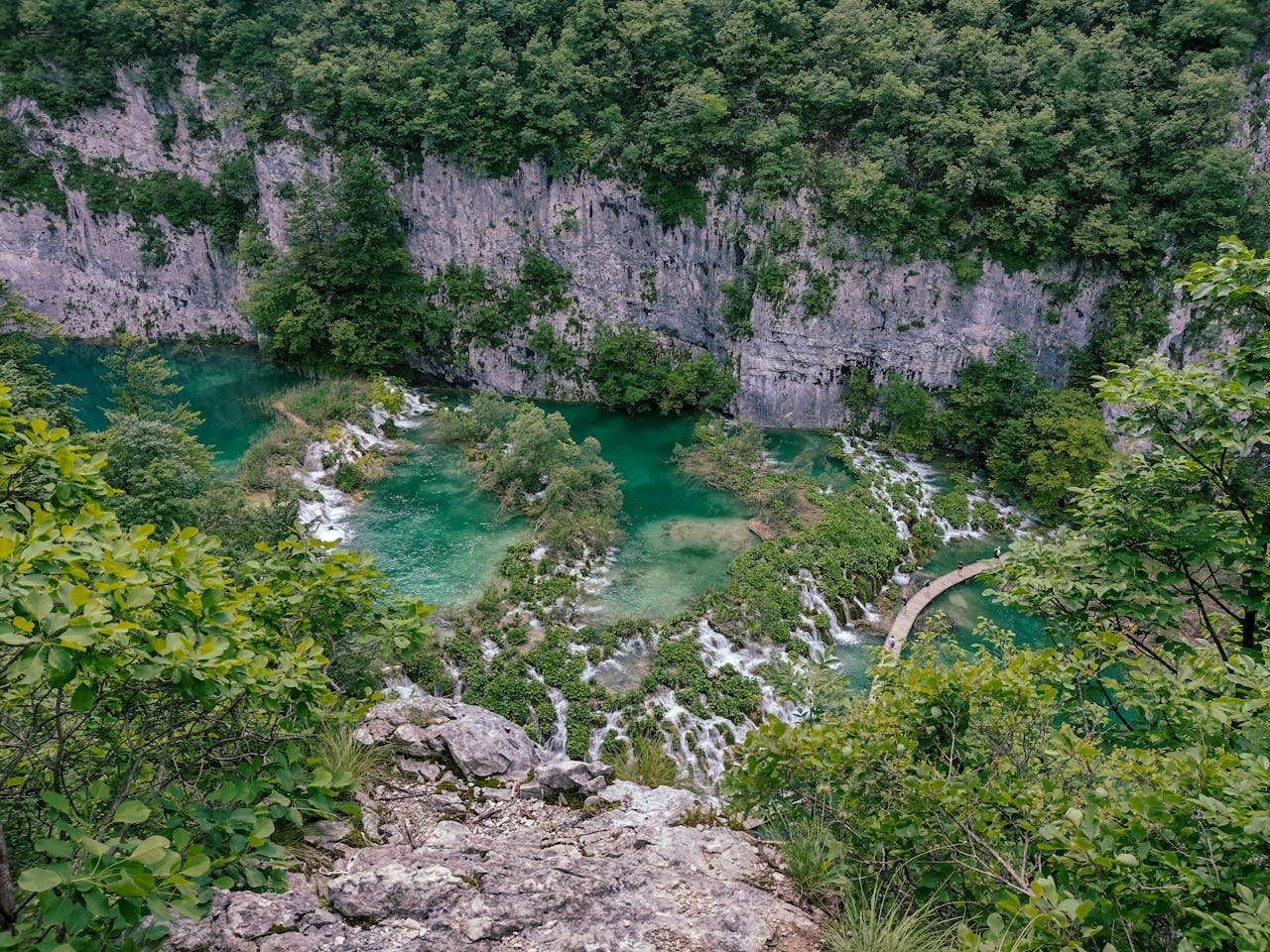
These measures include limiting daily entries and encouraging online ticket purchases in advance to control overcrowding.
A 2023 study by the University of Arizona on Croatian history and culture highlights the importance of preserving such natural heritage sites, noting that sustainable tourism practices are crucial for long-term ecological and economic benefits.
This proactive approach ensures that future generations can continue to experience the park’s unparalleled beauty.
Your Croatian Adventure Awaits
Croatia, with its breathtaking natural landscapes, ancient cities, and vibrant culture, truly offers an unparalleled travel experience.
Whether you’re drawn to the cascading lakes of Plitvice, the historic walls of Dubrovnik, the lively streets of Split, or the serene beauty of its islands, this diverse country promises an unforgettable journey.
From the sun-drenched beaches of the Adriatic to the charming inland towns, every corner of Croatia invites exploration and discovery.
As of 2025, Croatia continues to welcome travelers with open arms, offering a blend of rich history, stunning scenery, and warm hospitality.
With careful planning and an open mind, your Croatian adventure will be filled with cherished memories and a desire to return.
So, what are you waiting for?
Your ultimate Croatian escape is just a plane ride away to some of the best destinations in Croatia!
FAQ about Places to Visit in Croatia
What are the best places to visit in Croatia?
Some of the best places to visit in Croatia include Dubrovnik, known for its stunning old city and beautiful sunset views, Split, the second largest city in Croatia with its rich history, and the picturesque coastal towns in Dalmatia.
Additionally, cities like Zagreb, the capital of Croatia, and Šibenik, famous for its historic architecture, are must-see destinations.
Why should I visit Zagreb?
Zagreb, the capital city of Croatia, is a vibrant cultural hub filled with museums, galleries, and historical sites.
The city boasts a charming old town, lively cafes, and beautiful parks. It’s also a great starting point for exploring other regions of Croatia, making it one of the best places to visit during a trip.
What are some popular destinations in Dalmatia?
Dalmatia is home to several popular destinations such as Split, known for its Roman ruins, and Dubrovnik, often referred to as the “Pearl of the Adriatic.”
Other notable places include the stunning islands of Hvar and Brač, both offering beautiful beaches and vibrant nightlife.
Is Šibenik worth visiting?
Yes, Šibenik is worth a visit! This beautiful city is known for its well-preserved medieval architecture, including the UNESCO-listed St. James Cathedral.
It also provides access to nearby national parks, making it a great destination for nature lovers.
What is the best time of the year to visit Croatia?
The best time of the year to visit Croatia is during the spring and early fall when the weather is pleasant, and tourist crowds are smaller.
This is ideal for exploring cities like Zagreb and enjoying the stunning beaches along the Dalmatian coast.
Can you recommend some places to stay in Croatia?
There are numerous places to stay in Croatia, ranging from luxury hotels to charming guesthouses.
In Zagreb, consider staying in the city center for easy access to attractions.
In Dalmatia, beachfront hotels in Split or Dubrovnik offer stunning views and convenience.
How can I explore Central Croatia?
Central Croatia offers beautiful landscapes and charming towns. Renting a car is one of the best ways to explore this region, allowing you to visit places like Varazdin, known for its baroque architecture, and the beautiful countryside dotted with vineyards and picturesque villages.
What are the top places to visit in Croatia for nature lovers?
For nature lovers, the national parks of Croatia are top destinations. Plitvice Lakes National Park, a UNESCO World Heritage site, features stunning waterfalls and diverse flora and fauna.
Krka National Park, known for its beautiful waterfalls and swimming areas, is also a must-visit location.
What makes Dubrovnik a unique place to visit?
Dubrovnik is unique due to its well-preserved medieval walls and stunning architecture, earning it the nickname “The Pearl of the Adriatic,” and it’s one of the best destinations in Croatia.
The old city, a UNESCO World Heritage site, offers a picturesque setting filled with historical landmarks, making it one of the most beautiful cities in the world.




